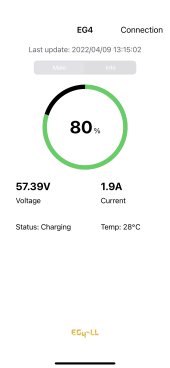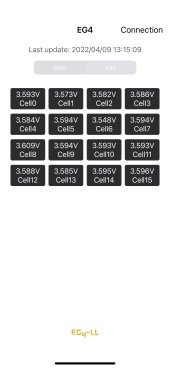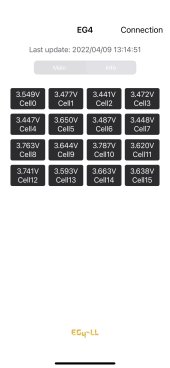Trkarl
New Member
A few weeks ago I purchased 3 EG4 waterproof 100 amp hour 48v batteries from Signature Solar. I am kind of confused about what I see on the monitoring ap with the cell voltages and state of charge. The specs downloaded from the signature solar website contradict themselves so I emailed tech support and was told to charge to 57.6 and float at 55.2 . However this is what happens when I do:





 Just as the absorption cycle has been going for about 5 minutes this is what the batteries show. I have the cycle run for 15 minutes but the batteries usually go into “standby” mode at about 7 minutes with 0 amps showing. It appears to me that the state of charge indicator for each battery is highly inaccurate and two of my batteries have unbalanced cells in them. As you can see 1 of the batteries has 4 cells that are over 3.8v and the lowest cell is at 3.44v. The other unbalanced battery has a high cell of 3.787v and low cell of 3.441v.
Just as the absorption cycle has been going for about 5 minutes this is what the batteries show. I have the cycle run for 15 minutes but the batteries usually go into “standby” mode at about 7 minutes with 0 amps showing. It appears to me that the state of charge indicator for each battery is highly inaccurate and two of my batteries have unbalanced cells in them. As you can see 1 of the batteries has 4 cells that are over 3.8v and the lowest cell is at 3.44v. The other unbalanced battery has a high cell of 3.787v and low cell of 3.441v.
The specs say cell overvoltage protection is at 3.9v. This seems awfully high to me from everything I have read.
I have reduced my charge voltage to 56 and still get cells in the unbalanced batteries that run above 3.65v.
Since these are sealed there is no way to take it apart to balance the unbalanced batteries. My concern is the cells with those voltages around 3.6v every charge cycle will degrade much quicker than the others. But if I don’t charge them high enough the unbalanced cells will just get more unbalanced. what are your opinions about this situation?





 Just as the absorption cycle has been going for about 5 minutes this is what the batteries show. I have the cycle run for 15 minutes but the batteries usually go into “standby” mode at about 7 minutes with 0 amps showing. It appears to me that the state of charge indicator for each battery is highly inaccurate and two of my batteries have unbalanced cells in them. As you can see 1 of the batteries has 4 cells that are over 3.8v and the lowest cell is at 3.44v. The other unbalanced battery has a high cell of 3.787v and low cell of 3.441v.
Just as the absorption cycle has been going for about 5 minutes this is what the batteries show. I have the cycle run for 15 minutes but the batteries usually go into “standby” mode at about 7 minutes with 0 amps showing. It appears to me that the state of charge indicator for each battery is highly inaccurate and two of my batteries have unbalanced cells in them. As you can see 1 of the batteries has 4 cells that are over 3.8v and the lowest cell is at 3.44v. The other unbalanced battery has a high cell of 3.787v and low cell of 3.441v.The specs say cell overvoltage protection is at 3.9v. This seems awfully high to me from everything I have read.
I have reduced my charge voltage to 56 and still get cells in the unbalanced batteries that run above 3.65v.
Since these are sealed there is no way to take it apart to balance the unbalanced batteries. My concern is the cells with those voltages around 3.6v every charge cycle will degrade much quicker than the others. But if I don’t charge them high enough the unbalanced cells will just get more unbalanced. what are your opinions about this situation?


